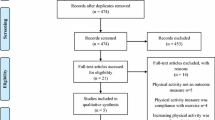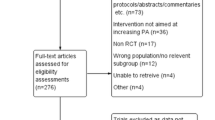Abstract
Physical activity (PA) and exercise programmes are recommended for the management of fibromyalgia. Despite positive effects on symptoms and function, PA promotion remains a significant clinical challenge. Behaviour change theories and techniques are recommended as part of complex health interventions; their integration into interventions aimed at PA behaviour in people with fibromyalgia is not known. This review explored behaviour change interventions targeting PA in adults with fibromyalgia. A systematic review was conducted; randomized and quasi-randomized controlled trials with at least one behaviour change intervention targeting PA were included. MEDLINE/OVID, EMBASE, PEDro, PsychINFO, CINAHL, Scopus, Web of Science, the Cochrane Central Register of Controlled Trials and relevant conference abstracts were searched. Two authors independently screened studies for inclusion and performed risk of bias assessments. Articles were reviewed for their use of behaviour change theory and behaviour change techniques (BCTs). The search identified 2491 records, from which eight studies (1416 participants) were included. PA and exercise behaviours were the primary focus of four interventions and were components of broader interventions in four studies. Behaviour change theories informed four interventions. Thirty-two different BCTs were used across studies. Five studies reported improvements in PA either post-intervention or at follow-up. Two studies used objective PA measures and seven studies used self-report measures. Short-term benefits in pain, quality of life, and physical fitness were also observed. Behaviour change interventions targeting PA in people with fibromyalgia have had limited success to date. With significant variations in intervention designs, the optimal intervention remains unknown.


Similar content being viewed by others
References
Schmidt-Wilcke T, Clauw DJ (2011) Fibromyalgia: from pathophysiology to therapy. Nat Rev Rheumatol 7(9):518–527
Wolfe F, Clauw DJ, Fitzcharles MA et al (2010) The American College of Rheumatology preliminary diagnostic criteria for fibromyalgia and measurement of symptom severity. Arthritis Care Res 62(5):600–610
Queiroz LP (2013) Worldwide epidemiology of fibromyalgia. Current Pain Headache Rep 17(8):356
Wolfe F, Walitt B (2013) Culture, science and the changing nature of fibromyalgia. Nat Rev Rheumatol 9:751
Macfarlane GJ, Kronisch C, Dean LE et al (2017) EULAR revised recommendations for the management of fibromyalgia. Ann Rheumatic Dis 76(2):318–328
Fitzcharles MA, Ste-Marie PA, Goldenberg DL et al (2013) 2012 Canadian Guidelines for the diagnosis and management of fibromyalgia syndrome: executive summary. Pain Res Manag 18(3):119–126
Bidonde J, Busch AJ, Schachter CL et al (2017) Aerobic exercise training for adults with fibromyalgia. Cochrane Database Syst Rev 6:CD012700
Busch AJ, Webber SC, Richards RS et al (2013) Resistance exercise training for fibromyalgia. Cochrane Database Syst Rev 12:CD010884
Bidonde J, Busch AJ, Webber SC et al (2014) Aquatic exercise training for fibromyalgia. Cochrane Database Syst Rev 10:CD011336
Caspersen CJ, Powell KE, Christenson GM (1985) Physical activity, exercise, and physical fitness: definitions and distinctions for health-related research. Public Health Rep 100(2):126–131
Donnelly JE, Blair SN, Jakicic JM, Manore MM, Rankin JW, Smith BK (2009) Appropriate physical activity intervention strategies for weight loss and prevention of weight regain for adults. Med Sci Sports Exerc 41(2):459–471
Warburton DER, Nicol CW, Bredin SSD (2006) Health benefits of physical activity: the evidence. Can Med Assoc J 174(6):801–809
WHO (2010) Global recommendations on physical activity for health. World Health Organization, Geneva
Arnold LM, Clauw DJ (2017) Challenges of implementing fibromyalgia treatment guidelines in current clinical practice. Postgrad Med 129(7):709–714
McLoughlin MJ, Colbert LH, Stegner AJ, Cook DB (2011) Are women with fibromyalgia less physically active than healthy women? Med Sci Sports Exerc 43(5):905–912
Kop WJ, Lyden A, Berlin AA et al (2005) Ambulatory monitoring of physical activity and symptoms in fibromyalgia and chronic fatigue syndrome. Arthritis Rheumatism 52(1):296–303
Bernard P, Hains-Monfette G, Atoui S, Kingsbury C (2018) Differences in daily objective physical activity and sedentary time between women with self-reported fibromyalgia and controls: results from the Canadian health measures survey. Clin Rheumatol 37:2285–2290
Segura-Jimenez V, Alvarez-Gallardo IC, Estevez-Lopez F et al (2015) Differences in sedentary time and physical activity between female patients with fibromyalgia and healthy controls: the al-Andalus project. Arthritis Rheumatol (Hoboken, NJ) 67(11):3047–3057
Bauman AE, Sallis JF, Dzewaltowski DA, Owen N (2002) Toward a better understanding of the influences on physical activity: the role of determinants, correlates, causal variables, mediators, moderators, and confounders. Am J Prevent Med 23(2 Suppl):5–14
Dobkin PL, Abrahamowicz M, Fitzcharles MA, Dritsa M, da Costa D (2005) Maintenance of exercise in women with fibromyalgia. Arthritis Rheumatism 53(5):724–731
Davis R, Campbell R, Hildon Z, Hobbs L, Michie S (2015) Theories of behaviour and behaviour change across the social and behavioural sciences: a scoping review. Health Psychol Rev 9(3):323–344
Michie S, Richardson M, Johnston M et al (2013) The behavior change technique taxonomy (v1) of 93 hierarchically clustered techniques: building an international consensus for the reporting of behavior change interventions. Ann Behav Med 46(1):81–95
Liberati A, Altman DG, Tetzlaff J et al (2009) The PRISMA statement for reporting systematic reviews and meta-analyses of studies that evaluate healthcare interventions: explanation and elaboration. BMJ 6:339
Higgins JPT, Green S (2011) Cochrane handbook for systematic reviews of interventions. Version 5.1.0. The Cochrane Collaboration, http://www.cochrane-handbook.org. Accessed Mar 2011
Higgins JPT, Altman DG, Gøtzsche PC et al (2011) The Cochrane Collaboration’s tool for assessing risk of bias in randomised trials. BMJ 343:d5928
Keel PJ, Bodoky C, Gerhard U, Muller W (1998) Comparison of integrated group therapy and group relaxation training for fibromyalgia. Clin J Pain 14(3):232–238
Schachter CL, Busch AJ, Peloso PM, Sheppard MS (2003) Effects of short versus long bouts of aerobic exercise in sedentary women with fibromyalgia: a randomized controlled trial. Phys Ther 83(4):340–358
Lorig KR, Ritter PL, Laurent DD, Plant K (2008) The internet-based arthritis self-management program: a one-year randomized trial for patients with arthritis or fibromyalgia. Arthritis Rheum 59(7):1009–1017
Fontaine KR, Conn L, Clauw DJ (2010) Effects of lifestyle physical activity on perceived symptoms and physical function in adults with fibromyalgia: results of a randomized trial. Arthritis Res Ther 12(2):R55
Stuifbergen AK, Blozis SA, Becker H et al (2010) A randomized controlled trial of a wellness intervention for women with fibromyalgia syndrome. Clin Rehabil 24(4):305–318
Ang DC, Kaleth AS, Bigatti S et al (2013) Research to encourage exercise for fibromyalgia (REEF): use of motivational interviewing, outcomes from a randomized-controlled trial. Clin J Pain 29(4):296–304
Hammond A, Freeman K (2006) Community patient education and exercise for people with fibromyalgia: a parallel group randomized controlled trial. Clin Rehabil 20(10):835–846
Larsson A, Palstam A, Lofgren M et al (2015) Resistance exercise improves muscle strength, health status and pain intensity in fibromyalgia—a randomized controlled trial. Arthritis Res Ther 17:161
Kim S, Slaven JE, Ang DC (2017) Sustained benefits of exercise-based motivational interviewing, but only among nonusers of opioids in patients with fibromyalgia. J Rheumatol 44(4):505–511
Steiner JL, Bigatti SM, Ang DC (2015) Trajectory of change in pain, depression, and physical functioning after physical activity adoption in fibromyalgia. J Health Psychol 20(7):931–941
Fontaine KR, Conn L, Clauw DJ (2011) Effects of lifestyle physical activity in adults with fibromyalgia: results at follow-up. J Clin Rheumatol Pract Rep Rheum Musculoskelet Dis 17(2):64–68
Grossman P, Deuring G, Walach H, Schwarzer B, Schmidt S (2017) Mindfulness-based intervention does not influence cardiac autonomic control or the pattern of physical activity in fibromyalgia during daily life: an ambulatory, multimeasure randomized controlled trial. Clin J Pain 33(5):385–394
Prestwich A, Sniehotta FF, Whittington C, Dombrowski SU, Rogers L, Michie S (2014) Does theory influence the effectiveness of health behavior interventions? Meta-analysis. Health Psychol 33(5):465–474
McDermott MS, Oliver M, Iverson D, Sharma R (2016) Effective techniques for changing physical activity and healthy eating intentions and behaviour: a systematic review and meta-analysis. Br J Health Psychol 21(4):827–841
Larkin L, Gallagher S, Cramp F, Brand C, Fraser A, Kennedy N (2015) Behaviour change interventions to promote physical activity in rheumatoid arthritis: a systematic review. Rheumatol Int 35(10):1631–1640
Keogh A, Tully MA, Matthews J, Hurley DA (2015) A review of behaviour change theories and techniques used in group based self-management programmes for chronic low back pain and arthritis. Manual Ther 20(6):727–735
Mc Sharry J, Olander EK, French DP (2015) Do single and multiple behavior change interventions contain different behavior change techniques? A comparison of interventions targeting physical activity in obese populations. Health Psychol 34(9):960–965
Sweet SN, Fortier MS (2010) Improving physical activity and dietary behaviours with single or multiple health behaviour interventions? A synthesis of meta-analyses and reviews. Int J Environ Res Public Health 7(4):1720–1743
Nigg CR, Long CR (2012) A systematic review of single health behavior change interventions vs. multiple health behavior change interventions among older adults. Transl Behav Med 2(2):163–179
Wilson K, Senay I, Durantini M et al (2015) When it comes to lifestyle recommendations, more is sometimes less: a meta-analysis of theoretical assumptions underlying the effectiveness of interventions promoting multiple behavior domain change. Psychol Bull 141(2):474–509
Conn VS, Hafdahl AR, Lemaster JW, Ruppar TM, Cochran JE, Nielsen PJ (2008) Meta-analysis of health behavior change interventions in type 1 diabetes. Am J Health Behav 32(3):315–329
Schoeppe S, Alley S, Van Lippevelde W et al (2016) Efficacy of interventions that use apps to improve diet, physical activity and sedentary behaviour: a systematic review. Int J Behav Nutr Phys Act 13(1):127
Kwasnicka D, Dombrowski SU, White M, Sniehotta F (2016) Theoretical explanations for maintenance of behaviour change: a systematic review of behaviour theories. Health Psychol Rev 10(3):277–296
Prince SA, Adamo KB, Hamel ME, Hardt J, Gorber SC, Tremblay M (2008) A comparison of direct versus self-report measures for assessing physical activity in adults: a systematic review. Int J Behav Nutr Phys Act 5(1):56
Author information
Authors and Affiliations
Contributions
All authors were involved in the design of the study. TOD, DM, and FW conducted the literature search. SM, FW, and TOD conducted the risk of bias appraisal. TOD extracted the data. TOD, SM, LD, and FW contributed to data analysis and interpretation. All authors reviewed and approved the final version of the manuscript.
Corresponding author
Ethics declarations
Conflict of interest
The authors declare that they have no conflicts of interest.
Additional information
Publisher’s Note
Springer Nature remains neutral with regard to jurisdictional claims in published maps and institutional affiliations.
Electronic supplementary material
Below is the link to the electronic supplementary material.
Rights and permissions
About this article
Cite this article
O’Dwyer, T., Maguire, S., Mockler, D. et al. Behaviour change interventions targeting physical activity in adults with fibromyalgia: a systematic review. Rheumatol Int 39, 805–817 (2019). https://doi.org/10.1007/s00296-019-04270-3
Received:
Accepted:
Published:
Issue Date:
DOI: https://doi.org/10.1007/s00296-019-04270-3




